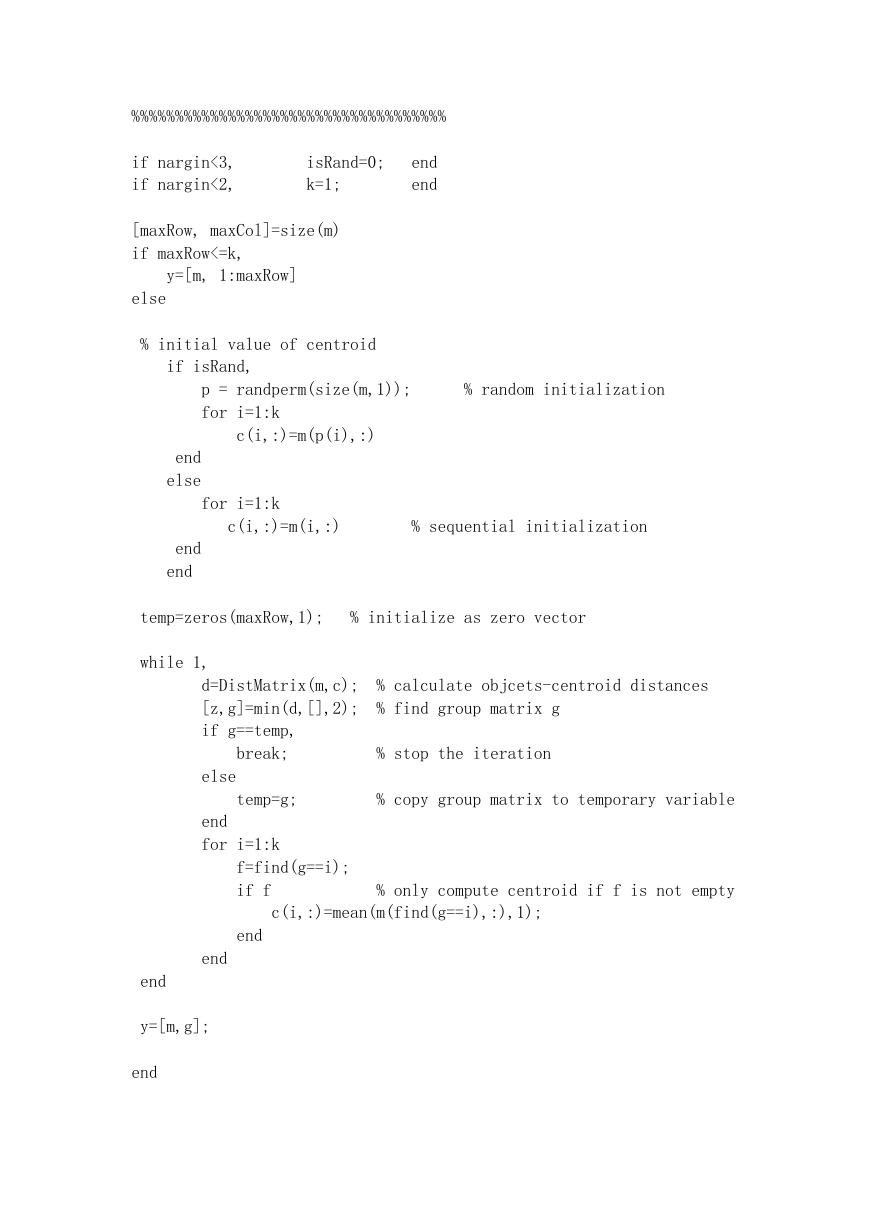function y=kMeansCluster(m,k,isRand)
%%%%%%%%%%%%%%%%
%
% kMeansCluster - Simple k means clustering algorithm
% Author: Kardi Teknomo, Ph.D.
%
% Purpose: classify the objects in data matrix based on the attributes
% Criteria: minimize Euclidean distance between centroids and object
points
% For more explanation of the algorithm, see
http://people.revoledu.com/kardi/tutorial/kMean/index.html
% Output: matrix data plus an additional column represent the group of
each object
%
% Example: m = [ 1 1; 2 1; 4 3; 5 4]
%
%
%
%
%
% kMeansCluster(m,k) produces m = [ 1 1 1;
2 1 1;
%
%
4 3 2;
%
5 4 2]
% Input:
%
columns
%
%
input any number (default)
%
%
% Local Variables
%
%
%
%
%
attributes
%
objects
%
%
f
c
g
i
maxCol - scalar number of rows in the data matrix m = number of
- row number of data that belong to group i
- centroid coordinate size (1:k, 1:maxCol)
- current iteration group matrix size (1:maxRow)
- scalar iterator
- optional, number of groups (default = 1)
k
isRand - optional, if using random initialization isRand=1, otherwise
maxRow - scalar number of columns in the data matrix m = number of
temp
z
- previous iteration group matrix size (1:maxRow)
- minimum value (not needed)
m
- required, matrix data: objects in rows and attributes in
or in a nice form
m = [ 1 1;
2 1;
4 3;
5 4]
k = 2
it will assign the first k data as initial centroids
�
%%%%%%%%%%%%%%%%%%%%%%%%%%%%%%%%%%%%
if nargin<3,
if nargin<2,
isRand=0;
k=1;
end
end
[maxRow, maxCol]=size(m)
if maxRow<=k,
y=[m, 1:maxRow]
else
% initial value of centroid
if isRand,
p = randperm(size(m,1));
for i=1:k
c(i,:)=m(p(i),:)
% random initialization
end
else
end
end
for i=1:k
c(i,:)=m(i,:)
% sequential initialization
temp=zeros(maxRow,1);
% initialize as zero vector
while 1,
d=DistMatrix(m,c);
[z,g]=min(d,[],2);
if g==temp,
% calculate objcets-centroid distances
% find group matrix g
break;
% stop the iteration
else
temp=g;
% copy group matrix to temporary variable
end
for i=1:k
f=find(g==i);
if f
% only compute centroid if f is not empty
c(i,:)=mean(m(find(g==i),:),1);
end
end
end
y=[m,g];
end
�
The Matlab function kMeansCluster above call function DistMatrix as shown
in the code below. It works for multi-dimensional Euclidean distance.
Learn about other type of distance here.
function d=DistMatrix(A,B)
%%%%%%%%%%%%%%%%%%%%%%%%%
% DISTMATRIX return distance matrix between points in A=[x1
y1 ... w1] and in B=[x2 y2 ... w2]
% Copyright (c) 2005 by Kardi Teknomo,
http://people.revoledu.com/kardi/
%
% Numbers of rows (represent points) in A and B are not
necessarily the same.
% It can be use for distance-in-a-slice (Spacing) or
distance-between-slice (Headway),
%
% A and B must contain the same number of columns (represent
variables of n dimensions),
% first column is the X coordinates, second column is the
Y coordinates, and so on.
A=[1 2 3; 4 5 6; 2 4 6; 1 2 3]; B=[4 5 1; 6 2 0]
dist(A,B)= [ 4.69
5.00
5.48
4.69
% The distance matrix is distance between points in A as rows
% and points in B as columns.
% example: Spacing= dist(A,A)
% Headway = dist(A,B), with hA ~= hB or hA=hB
%
%
%
%
%
%
%
%
%%%%%%%%%%%%%%%%%%%%%%%%%%%
[hA,wA]=size(A);
[hB,wB]=size(B);
if wA ~= wB,
error(' second dimension of A and B must be
dist(B,A)= [ 4.69
5.83
5.00
7.00
5.83;
7.00;
7.48;
5.83]
5.48
7.48
4.69;
5.83]
the same'); end
for k=1:wA
C{k}= repmat(A(:,k),1,hB);
D{k}= repmat(B(:,k),1,hA);
end
S=zeros(hA,hB);
for k=1:wA
S=S+(C{k}-D{k}').^2;
�
end
d=sqrt(S);
�








 2023年江西萍乡中考道德与法治真题及答案.doc
2023年江西萍乡中考道德与法治真题及答案.doc 2012年重庆南川中考生物真题及答案.doc
2012年重庆南川中考生物真题及答案.doc 2013年江西师范大学地理学综合及文艺理论基础考研真题.doc
2013年江西师范大学地理学综合及文艺理论基础考研真题.doc 2020年四川甘孜小升初语文真题及答案I卷.doc
2020年四川甘孜小升初语文真题及答案I卷.doc 2020年注册岩土工程师专业基础考试真题及答案.doc
2020年注册岩土工程师专业基础考试真题及答案.doc 2023-2024学年福建省厦门市九年级上学期数学月考试题及答案.doc
2023-2024学年福建省厦门市九年级上学期数学月考试题及答案.doc 2021-2022学年辽宁省沈阳市大东区九年级上学期语文期末试题及答案.doc
2021-2022学年辽宁省沈阳市大东区九年级上学期语文期末试题及答案.doc 2022-2023学年北京东城区初三第一学期物理期末试卷及答案.doc
2022-2023学年北京东城区初三第一学期物理期末试卷及答案.doc 2018上半年江西教师资格初中地理学科知识与教学能力真题及答案.doc
2018上半年江西教师资格初中地理学科知识与教学能力真题及答案.doc 2012年河北国家公务员申论考试真题及答案-省级.doc
2012年河北国家公务员申论考试真题及答案-省级.doc 2020-2021学年江苏省扬州市江都区邵樊片九年级上学期数学第一次质量检测试题及答案.doc
2020-2021学年江苏省扬州市江都区邵樊片九年级上学期数学第一次质量检测试题及答案.doc 2022下半年黑龙江教师资格证中学综合素质真题及答案.doc
2022下半年黑龙江教师资格证中学综合素质真题及答案.doc